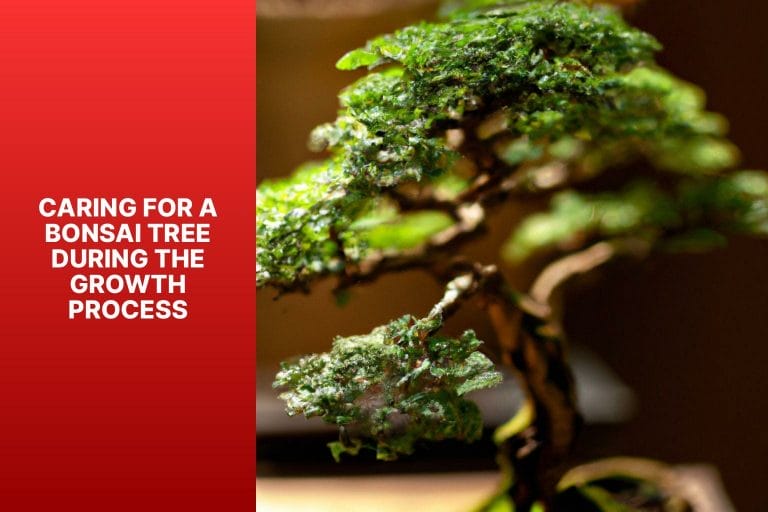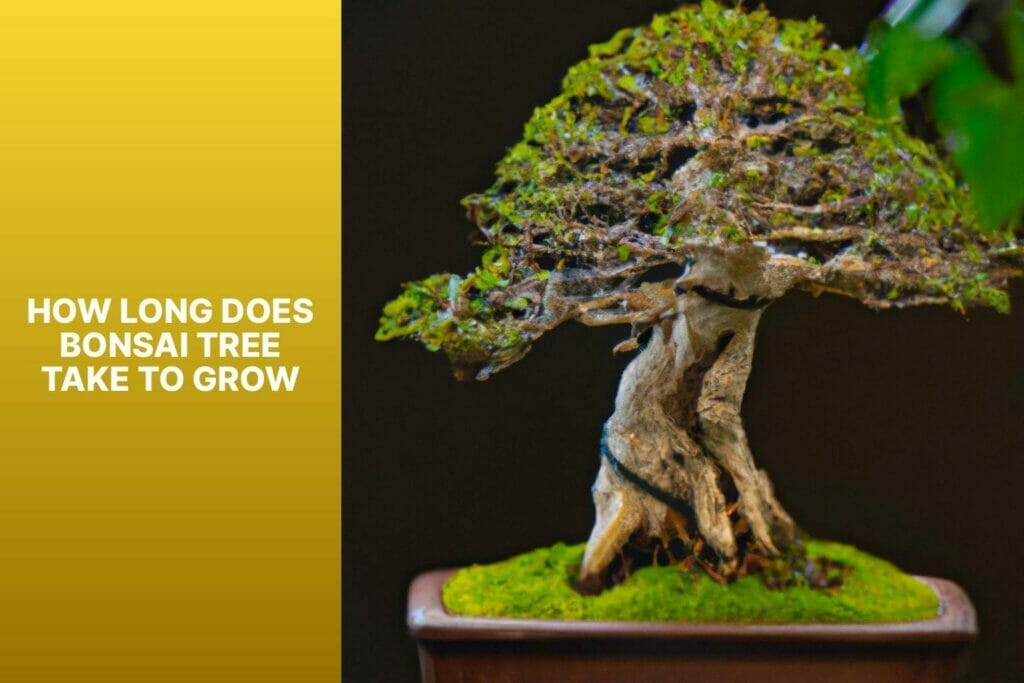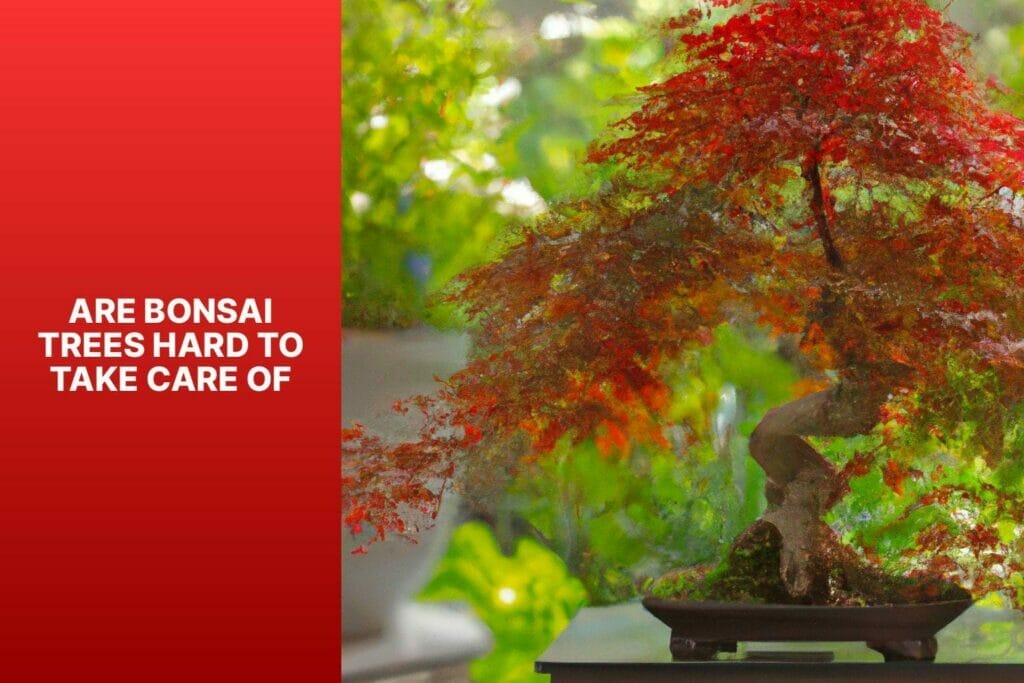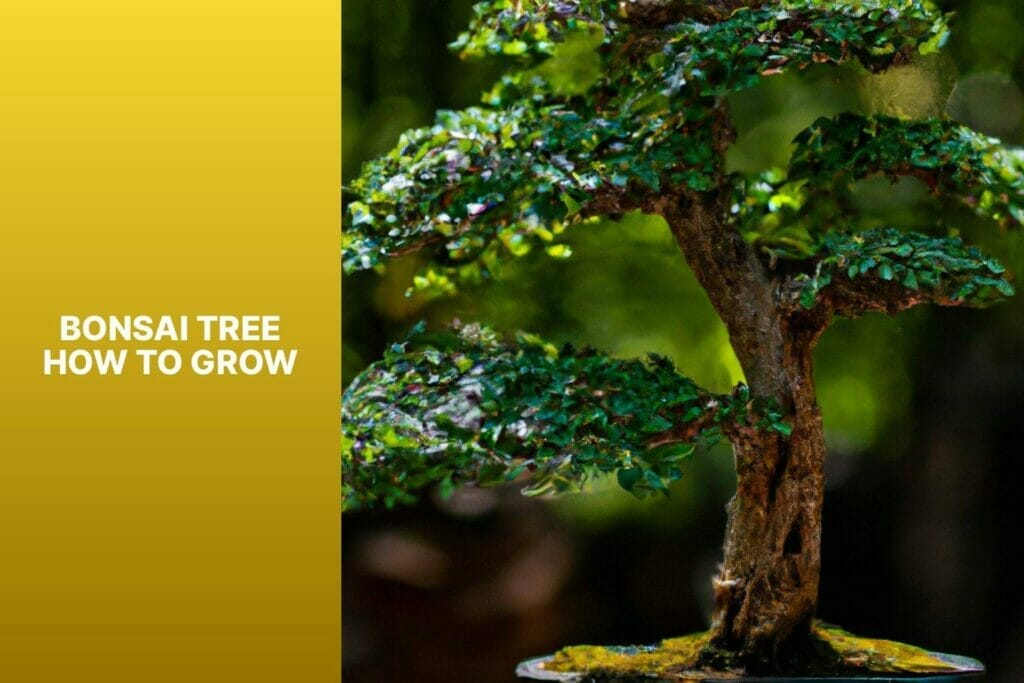A bonsai tree is a miniature tree meticulously cultivated and shaped to resemble a full-sized tree. It is a living art form that requires patience, skill, and an understanding of its growth process. One common question that arises among bonsai enthusiasts is how long it takes for a bonsai tree to grow. The growth rate of bonsai trees can vary widely depending on various factors. This article will explore the factors that affect the growth rate of bonsai trees and provide insights into the typical timeframe for bonsai tree growth.
Factors Affecting the Growth Rate of Bonsai Trees:
1. Bonsai Species: Different species of trees have different growth rates, with some species growing faster than others.
2. Environmental Conditions: The environment plays a crucial role in the growth of bonsai trees. Factors such as temperature, humidity, and sunlight can impact their growth.
3. Care and Maintenance: Proper care and maintenance, including watering, pruning, and fertilizing, can significantly influence the growth rate of bonsai trees.
Understanding the Growth Process of Bonsai Trees:
Before delving into the timeframe for bonsai tree growth, it is important to understand the growth process of these miniature trees. Bonsai trees go through several stages, including seed germination, nursery stage, and training and shaping stage. Each stage contributes to the overall growth and development of the bonsai tree.
Typical Timeframe for Bonsai Tree Growth:
The timeframe for bonsai tree growth can vary greatly depending on the species, techniques used, and environmental factors. Generally, it takes several years for a bonsai tree to develop and reach its desired shape and size.
Factors That Can Influence the Time Taken for Bonsai Trees to Grow:
1. Size and Age of the Tree: Larger and older bonsai trees may take longer to grow and develop than younger and smaller trees.
2. Training Techniques Used: Different training techniques, such as wiring and pruning, can affect the growth rate and shape of the bonsai tree.
3. Climate and Seasonal Variations: The climate and seasonal variations in your region can impact the growth rate of bonsai trees. Some species may have specific growth patterns associated with certain seasons.
Caring for a Bonsai Tree During the Growth Process:
Proper care and maintenance are crucial for the healthy growth of bonsai trees. This includes regular watering, pruning, and fertilizing to provide the necessary nutrients and create the desired shape.
By understanding the factors that affect the growth rate of bonsai trees and following proper care techniques, enthusiasts can cultivate beautiful and thriving bonsai trees that will serve as a source of joy and admiration for years to come.
Key takeaway:
- Various factors, including tree species, environmental conditions, and care and maintenance, can influence the growth rate of bonsai trees.
- The growth process of bonsai trees involves different stages, such as seed germination, nursery stage, and training and shaping stage.
- The time taken for bonsai trees to grow can vary depending on factors like the size and age of the tree, training techniques used, and climate and seasonal variations.
Factors Affecting the Growth Rate of Bonsai Trees
Curious about how long it takes for a bonsai tree to grow? Let’s dive into the factors that influence the growth rate of these miniature marvels. Each sub-section unveils key elements that contribute to their growth, from the specific bonsai species to the environmental conditions and the care and maintenance they require. So, buckle up as we explore the fascinating world of bonsai trees and unravel the secrets behind their development.
Bonsai Species
– Chinese Elm: A popular bonsai species with small leaves and strong branches that can tolerate various climates. Chinese Elm is a great choice when considering different bonsai species.
– Juniper: This species has unique, twisting branches and lush green foliage. It adapts well to different environments, making Juniper one of the most sought-after bonsai species.
– Maple: Maple bonsai trees have vibrant colors, especially in autumn. They require more maintenance but are beautiful. Maple is a remarkable bonsai species for those who enjoy vibrant foliage.
– Ficus: Ficus bonsai trees are resilient and adaptable, making them a common choice for beginners. They have shiny, attractive leaves. Ficus is widely regarded as a beginner-friendly bonsai species.
– Pine species make striking bonsai trees with needle-like leaves and rough bark. They need sunlight and cooler temperatures to thrive. Pine is a stunning bonsai species that thrives in specific conditions.
Pro-tip: When choosing a bonsai species, consider your experience, climate, and time commitment. Each bonsai species has unique requirements, so choose one that aligns with your preferences and capabilities. Patience and proper care are key to the healthy growth of any bonsai species.
Environmental Conditions
Environmental conditions play a crucial role in the growth of bonsai trees. Several important factors must be considered, including temperature, humidity, light, air circulation, watering, and soil quality.
Temperature is key, as bonsai trees thrive in moderate temperatures ranging from 60 to 75 degrees Fahrenheit (15 to 24 degrees Celsius). Extreme temperatures can be harmful to these delicate plants.
Balanced humidity levels of approximately 50% to 70% are essential for optimal bonsai tree growth. High humidity can encourage fungal growth, while low humidity can lead to dehydration.
Different species of bonsai trees have varying light requirements, but they generally thrive in bright, indirect light. Placing them near a window or using grow lights can provide the necessary light.
Good air circulation is necessary to prevent stagnant air, leading to disease or pests. Ensuring the trees are placed in an area with adequate airflow enhances their overall health.
Proper watering is crucial for the growth of bonsai trees. Most species require regular watering to keep the soil moist but not soggy. Adequate drainage is also important to prevent soggy roots.
Using well-draining bonsai soil that contains organic matter is essential. This type of soil provides the necessary nutrients and oxygen to the roots.
By managing these environmental conditions, bonsai tree enthusiasts can create an ideal environment for their trees, promoting healthy growth and longevity.
Care and Maintenance
Edited
Care and Maintenance
When caring for a bonsai tree, consider these factors:
– Watering: Bonsai trees need regular watering, but not too much. The frequency depends on pot size, soil type, and weather conditions. Check the soil moisture regularly and adjust the watering schedule accordingly.
– Pruning and Trimming: Regular pruning and trimming maintain the desired shape and size of the tree. This controls growth, promotes new foliage, and maintains a balanced structure. Use sharp tools for precise pruning to avoid damaging the tree.
– Fertilizing: Bonsai trees require regular feeding with a balanced fertilizer for healthy growth. The frequency and type depend on the tree species. Follow fertilizer instructions and avoid overfeeding, which can harm the tree.
Pro-tip: Observe your bonsai tree closely and adjust it based on its unique needs. Understanding its specific requirements ensures overall health and longevity.
Understanding the Growth Process of Bonsai Trees
Understanding the growth process of bonsai trees is crucial for bonsai enthusiasts. Here are key aspects to consider:
1. Patience: Bonsai trees grow slowly compared to their larger counterparts.
2. Training: Regular pruning, wiring, and shaping are necessary to achieve bonsai trees’ desired shape and form.
3. Watering: Maintaining consistent moisture in the soil is important for the health and growth of bonsai trees.
4. Light: Bonsai trees should be placed where they can receive sufficient sunlight.
5. Fertilization: A balanced fertilizer for bonsai trees is necessary for growth.
6. Repotting: Periodically repotting bonsai trees helps ensure healthy growth.
By understanding the growth process of bonsai trees, you can cultivate these miniaturized trees with precision and care, creating stunning artistic masterpieces.
Typical Timeframe for Bonsai Tree Growth
Are you curious about how long it takes for a bonsai tree to reach its majesty? Let’s explore the various stages of bonsai tree growth, including seed germination, the nursery stage, and training and shaping. From the humble beginnings of a tiny seed to the intricate art form of shaping and training, we’ll uncover the fascinating timeline of a bonsai tree’s development. Get ready to discover the patience, care, and dedication required to cultivate these miniature wonders of nature.
Seed Germination Stage
The seed germination stage is the start of a bonsai tree’s growth. The seed undergoes important processes that lead to the emergence of a seedling. Here are the key aspects to consider:
1. Proper timing: Different bonsai tree seeds have specific germination requirements. Some seeds need cold stratification, while others require scarification or soaking. Research the requirements for the particular tree species you’re working with.
2. Preparation: Ensure the growing medium is well-drained and moist before planting the seeds. Use a seed tray or small pots and fill them with a suitable bonsai tree soil mix.
3. Planting: Sow the seeds at the recommended depth as instructed. It’s best to plant multiple seeds in case some fail to germinate.
4. Moisture: Consistently moisten the growing medium to support seed germination. Water the seeds gently to avoid displacing them. You can cover the pots with plastic wrap to maintain humidity.
5. Temperature: Most bonsai tree seeds need warm temperatures to germinate. Place the pots in a warm location near a heat source or on a heat mat if needed.
6. Patience: Germination times can vary widely, ranging from a few days to weeks or months. Be patient and avoid disturbing the seeds during this crucial stage. Some seeds may benefit from cold stratification before germination.
Pro-tip: Label your pots with the tree species and planting date to track each seed’s progress. Regularly check moisture levels and provide necessary care for successful germination.
Nursery Stage
During the nursery stage of bonsai tree growth, it is crucial to consider several factors to nurture healthy trees successfully.
- One important aspect is to choose high-quality bonsai tree seeds from reputable sources.
- It is essential to use a well-draining potting mix to promote root development.
- To ensure optimal growth, maintain a consistent temperature range suitable for your bonsai tree species (60-85°F or 15-30°C).
- It is important to provide adequate moisture for seed germination while preventing waterlogging.
- Place the nursery container in a well-lit area with proper ventilation to prevent fungal growth.
- Another crucial step is regularly applying a balanced liquid fertilizer to promote growth.
- Inspect the tree for pests, diseases, and signs of stress and prune accordingly.
- As the bonsai tree outgrows the nursery container, it must be transplanted into a larger pot.
- It is important to observe and make adjustments to care techniques to ensure healthy development.
Following these guidelines during the nursery stage can establish a strong foundation for your bonsai tree’s growth and development.
Training and Shaping Stage
During the training and shaping stage of bonsai tree growth, important considerations must be made to achieve the desired form and aesthetics of the tree.
1. Pruning: Prune branches and foliage regularly to control growth and shape.
2. Wiring: Use wiring to manipulate branches and trunks. Wrap the wire around branches to guide growth. Monitor wiring to prevent tree damage.
3. Branch positioning: Adjust branches for better balance and symmetry. Bend and secure branches using wire or clips.
4. Root pruning: Trim excess roots to maintain a healthy root system and prevent root-binding. Encourage new growth and compact roots.
5. Defoliation: Remove leaves to encourage smaller, compact growth.
The training and shaping stage requires patience and careful observation. Regular monitoring and adjustments are necessary to achieve the desired form and balance in the bonsai tree.
Factors That Can Influence the Time Taken for Bonsai Trees to Grow

Photo Credits: Mnbonsainetwork.Com by Aaron Lopez
The factors influencing the bonsai trees’ growth time are as diverse as the trees. Let’s uncover the key elements that can impact the timeline of bonsai tree development. From the size and age of the tree to the training techniques employed, as well as the ever-changing climate and seasonal variations – we’ll journey through these sub-sections to gain deeper insight into the fascinating world of bonsai tree growth.
Size and Age of the Tree
When it comes to bonsai trees, the crucial factors in their growth and development are the size and age of the tree. Bonsai trees vary greatly in size, ranging from small to large. Smaller bonsai trees are easier to manage and suitable for beginners or those with limited space. Larger bonsai trees require more care and attention due to their size and the complexity of pruning and styling.
The age of a bonsai tree also affects its growth and appearance. Young bonsai trees are more flexible and responsive to training techniques, allowing for greater control over their shape and design. As bonsai trees age, their branches and trunk become more solid and rigid, making it harder to alter their structure. It’s important to consider the size and age of the tree when choosing a bonsai. These factors determine the level of commitment and skill required for its care.
Smaller, younger trees are generally easier to work with and require less maintenance. In contrast, larger, older trees can be more demanding but offer a more established and refined look.
Training Techniques Used
- Regular pruning shapes and trains bonsai trees. Selectively removing branches and foliage controls growth and creates desired shapes. Pruning also promotes new growth and improves overall health.
- Wrapping wires around branches guides growth and creates desired shapes. Care must be taken to avoid damaging or breaking branches.
- Removing leaves stimulates new growth and reduces leaf size. Typically done on deciduous trees during the growing season.
- Removing tips of new shoots controls growth and encourages branching. Commonly used for coniferous bonsai trees.
- Regular root pruning prevents root-bound trees. Trimming or removing roots maintains a healthy root system and encourages new growth.
When using training techniques on bonsai trees, remember that each tree species has specific needs and tolerances. Research and understand the requirements of your bonsai tree to ensure effective training techniques. Be patient and allow the tree sufficient time to respond. With proper care and the right techniques, bonsai trees can be shaped into beautiful, miniature works of art.
Climate and Seasonal Variations
Climate and Seasonal Variations play a significant role in bonsai tree growth. The table below shows how different climate conditions and seasonal variations impact growth.
| Climate | Impact on Bonsai Growth |
| Hot and Dry | Requires frequent watering to prevent dehydration. Increased evaporation leads to faster soil drying. |
| Cold and Frosty | Dormancy period for certain bonsai species during winter. Protecting from frost is crucial to prevent damage. |
| Mild and Humid | Provides favorable conditions for bonsai growth. Bonsai trees thrive in areas with higher humidity. |
| Seasonal Changes | Influences bonsai tree growth cycle. Different seasons require specific care and maintenance practices. |
To ensure the best results, research and understand the specific climate requirements of the bonsai species you are cultivating. Adjust watering schedules, provide protection during extreme weather conditions, and adapt care techniques for successful bonsai cultivation in varied climates and seasonal variations.
Caring for a Bonsai Tree During the Growth Process

Photo Credits: Mnbonsainetwork.Com by Billy Ramirez
Caring for a bonsai tree during growth is crucial to ensure its vitality and beauty. In this section, we’ll explore the essential tasks that need attention: watering, pruning and trimming, and fertilizing. Discover the secrets to maintaining the perfect moisture balance, encouraging healthy growth, and nurturing the delicate branches and leaves. Get ready to delve into the art of bonsai tree care and witness the transformative results of proper nurturing techniques.
Watering
Watering is crucial for the growth and health of a bonsai tree. Here are some key points to consider:
1. Consistency: Bonsai trees need regular watering. The frequency may vary based on pot size, soil type, and local climate. A general guideline is to water when the topsoil is slightly dry but not completely dry.
2. Watering Techniques: Thoroughly water the bonsai tree, avoiding superficial watering. Water until it drains from the pot’s drainage holes, ensuring the roots receive enough moisture.
3. Water Quantity: The amount of water depends on the tree’s size, age, and species. Strike a balance to avoid overwatering (leading to root rot) or underwatering (causing dehydration).
4. Water Quality: Bonsai trees thrive with good quality water. Using filtered water or rainwater can prevent mineral and chemical buildup from tap water.
5. Observation: Pay attention to the tree’s response to watering. Wilted or yellow leaves may indicate underwatering while rotting soil suggests overwatering. Adjust the watering schedule accordingly.
I once neglected to water a bonsai tree properly. Irregular watering caused the tree’s leaves to turn brown and lose vitality. Realizing my mistake, I adjusted the watering routine, providing consistent moisture. Over time, the bonsai tree revived, and its leaves regained their vibrant green color. This experience taught me the importance of diligent and consistent watering for bonsai tree care.
Pruning and Trimming
Pruning and trimming are crucial practices in caring for and maintaining bonsai trees. These practices play a vital role in maintaining the desired shape and size of the trees and promoting better branch structure, growth, and overall health.
When it comes to pruning, it is best to carry out major pruning during the spring and early summer seasons. Light pruning can be performed as needed throughout the year. Various techniques can achieve the desired outcome, including branch trimming, leaf pruning, and root pruning.
To effectively prune bonsai trees, it is essential to utilize appropriate tools such as pruning shears, branch cutters, and concave cutters. These tools enable clean and precise cuts, which are essential for the health and development of the trees. The frequency of pruning depends on the tree’s growth rate and specific requirements. Regular observation and assessment will help determine when pruning is necessary.
Fertilizing
When fertilizing bonsai trees, providing the right nutrients for growth and health is important. A balanced fertilizer for bonsai trees is recommended, containing nitrogen, phosphorus, and potassium. It is best to fertilize the trees during the growing season, from spring to early fall. It is advised to avoid fertilizing during winter or dormant periods.
When applying the fertilizer, following the instructions on the packaging is crucial. Pay close attention to the dosage and frequency to prevent any harm to the tree. Over-fertilizing can be detrimental.
The fertilizer should be applied evenly across the soil surface to ensure even growth and prevent root burn. It is essential to avoid concentrating the fertilizer in one particular area.
After fertilizing, it is important to monitor the tree’s response. Observe signs of growth and improvements in health. If necessary, make adjustments to the fertilizer application. By providing the appropriate fertilizer and following these best practices, you can promote the growth and vitality of your bonsai tree.
”’
Some facts about how long does bonsai tree take to grow:
- It takes at least five years for a bonsai tree to reach a miniature size and another 10 to 15 years to reach maturity.
- Bonsai trees take 10 to 15 years to grow from seed to adult plants.
- Bonsai trees can live for 50-80 years or longer with proper care and a favorable environment.
- Some varieties of bonsai trees, like Aspen, Juniper, Maple, Ficus, Jade, and Weeping Willow, mature faster than others.
- There is no specific answer to the question of how long it takes to grow a bonsai tree, as some believe that a bonsai tree is never finished growing, while others argue that once a tree has been stunted, the growing ends and the nurturing begins.
”’


